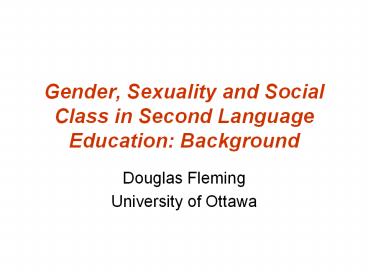Gender, Sexuality and Social Class in Second Language Education: Background - PowerPoint PPT Presentation
Title:
Gender, Sexuality and Social Class in Second Language Education: Background
Description:
Gender, Sexuality and Social Class in Second Language Education: Background Douglas Fleming University of Ottawa As Lemonick (1992) has noted, about one person in ... – PowerPoint PPT presentation
Number of Views:345
Avg rating:3.0/5.0
Title: Gender, Sexuality and Social Class in Second Language Education: Background
1
Gender, Sexuality and Social Class in Second
Language Education Background
- Douglas Fleming
- University of Ottawa
2
- As Lemonick (1992) has noted, about one person in
20,000 are genetically of a different sex than
their outward appearance would suggest. - Men generally have greater upper body strength,
larger muscle mass and joint structures, thicker
skin and lower awareness thresholds of injury. - Women, on the other hand, seem to have greater
tolerance for pain and better long-term physical
endurance.
3
- When considering behavior, the differences
between men and women are difficult to classify
in terms of being biologically determinate. How
much is due to nature and how much to nurture? - John Gray, the author of Men are from Mars, Women
are from Venus contends that the sexes approach
problem-solving differently. - Do you buy his arguments?
4
- Gender, as opposed to sex, is the way in which
one sees ones own sexual role. - Needless to say, social influences have a big
role to play in this important aspect of
self-perception. - Ones physical sex might very well be clear
enough from birth (although many would dispute
this). - However, gender is learned.
5
- People who do not fit into the binary division of
gender are subject to pressures to conform. - Gay men, lesbian women, bisexuals or
transgendered people behave sexually outside the
dominant norm within society and are thus
commonly subject to pressures to conform to
preconceived notions of what constitutes gender. - This binary division also promotes the attitude
that sexual identity and behavior should be
consistent and clearly demarcated against an
opposite.
6
- As Beasley (2005) notes, the fact that the
masculine is accorded higher value than the
feminine can be demonstrated linguistically. - Feminine equivalents (spinster as opposed to
bachelor, for example) are usually interpreted
negatively. Feminine names often contain
diminutives (waitress, as opposed to waiter).
7
- The battles over politically correct
terminology occur because some contend that
making a conscious effort at using PC words is a
way of conscious-raising that hopefully affects
attitudes AND behaviors. - Breaking linguistic conventions is difficult,
given the constructionist nature of language.
8
- great effort has been made to deny the very
existence of class (Teeple, 2000). - Despite a recently dramatic concentration of
wealth in the U.S. (see http//concentrationof
wealth.blogspot.com) - Liberal (small l) forms of citizenship, for
example, in which everyone enjoys equal access to
a common set of rights and privileges masks
social and economically-based inequalities
(Marshall, 1950).
9
- The supposed basis of class is not biological,
but socio-economic. - As opposed to race and gender, the outward
appearance of class is generally more easily
discarded. In other words, it is easier to hide
ones class origins as opposed those pertaining
to ones race or gender. - One can also change class membership in ways that
are not dependent on physical attributes.
10
- We are used to equating class primarily with
wealth and secondarily with access to educational
resources. - Given how social stratification is represented
ideologically, we are also using to viewing class
as being relatively fluid and based on merit. - However, it is important to note class is as
socially constructed as race and gender. - Proof of this is in how societies have classified
social stratification in various ways.
11
- The Indian caste system in its traditional
formulation, for example, is quite rigid in terms
of social mobility. - Native social hierarchies were quite variable.
- Traditional Confucius Chinese social
stratification
12
- Even within modern European notions of class,
there are important variations. - Pre-revolutionary France was marked by the three
estates (church aristocracy/ military and
everyone else). - The traditional British system divided society
into the aristocracy and the commons. - It could be argued that communist countries have
divided classes according to party membership.
13
- Social stratification is marked by ones wealth,
income, education and placement in an overarching
system that ascribes value to various
occupational statuses (esp. in terms of
governmental, military and religious structures).
- Class is symbolically represented through manners
and clothing, membership in high status
organizations, honorific titles bestowed by
organizations that exercise power, and language
use.
14
- Formalized descriptions of class structures do
not (usually) reflect power relations accurately. - Stories about individual merit (e.g. Horatio
Alger) will often make class membership in modern
capitalist societies appear to be much more fluid
than it really is. - As in the case of race, meritocratic standards
allow one to blame the victims, this time the
poor.
15
- Financial capital passed down from family members
perpetuates class divisions in obvious ways.
However, other factors also play a hand. - Cultural capital (Bourdieu,1977) is a set of
non-materialist resources related to family
background, social status (as opposed to economic
class) and education that is passed down from
generation to generation. - Different values are found within hierarchical
forms of cultural capital that can be variously
transformed into the more tangible material forms
of capital, such as money and power.































